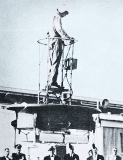|
 Hiller Aircraft Corporation, founded by Stanley Hiller Jr., was indeed involved
in the development of various helicopters and unconventional aircraft, including
"Flying
Platforms." The Flying Platform was an experimental vertical takeoff and landing
(VTOL) aircraft that Hiller developed in the 1950s. Hiller Aircraft Corporation, founded by Stanley Hiller Jr., was indeed involved
in the development of various helicopters and unconventional aircraft, including
"Flying
Platforms." The Flying Platform was an experimental vertical takeoff and landing
(VTOL) aircraft that Hiller developed in the 1950s.
The Hiller Flying Platform, also known as the "Hiller VZ-1 Pawnee," was a small,
one-person aircraft with no wings or fuselage. It consisted of a central engine
and a platform on which the pilot would stand. The pilot controlled the aircraft's
movement by shifting their body weight, similar to how one would control a Segway.
The platform had rotor blades that provided lift and propulsion.
The Flying Platform used a ducted fan for vertical lift and control. It was designed
to be highly maneuverable and versatile, capable of hovering, flying forward, backward,
sideways, and making quick turns. The aircraft was primarily developed for military
applications, such as reconnaissance and transportation of soldiers in challenging
terrains.
Although the Flying Platform demonstrated promising capabilities, it faced challenges
in stability and control, and the project did not progress beyond the prototype
stage. However, Hiller's work on the Flying Platform contributed to advancements
in VTOL technology and influenced future developments in rotorcraft design.
 This
content was generated by primarily the ChatGPT (OpenAI),
and/or Gemini (Google),
and/or Arya (GabAI),
and/or Grok
3 (x.AI)
artificial intelligence (AI) engine. Some review was performed to help detect
and correct any inaccuracies; however, you are encouraged to verify the
information yourself if it will be used for critical applications. In some
cases, multiple solicitations to the AI engine(s) was(were) used to assimilate
final content. Images and external hyperlinks have also been added occasionally.
Courts have ruled that AI-generated content is not subject to copyright
restrictions, but since I modify them, everything here is protected by RF Cafe
copyright. Many of the images are likewise generated and modified. Your
use of this data implies an agreement to hold totally harmless Kirt
Blattenberger, Airplanes and Rockets, and any and all of its assigns. Thank you.
Here are the major categories: This
content was generated by primarily the ChatGPT (OpenAI),
and/or Gemini (Google),
and/or Arya (GabAI),
and/or Grok
3 (x.AI)
artificial intelligence (AI) engine. Some review was performed to help detect
and correct any inaccuracies; however, you are encouraged to verify the
information yourself if it will be used for critical applications. In some
cases, multiple solicitations to the AI engine(s) was(were) used to assimilate
final content. Images and external hyperlinks have also been added occasionally.
Courts have ruled that AI-generated content is not subject to copyright
restrictions, but since I modify them, everything here is protected by RF Cafe
copyright. Many of the images are likewise generated and modified. Your
use of this data implies an agreement to hold totally harmless Kirt
Blattenberger, Airplanes and Rockets, and any and all of its assigns. Thank you.
Here are the major categories:
Airplane Models & History |
Helicopter Models & History |
Rocket Models & History | Aeronautical &
Aerospace History | Aeronautical &
Aerospace Companies | Aeronautical & Aerospace Pioneers |
Aeronautical & Aerospace
Terms & Definitions
|



